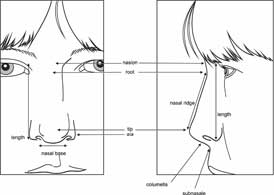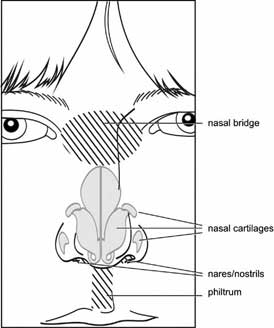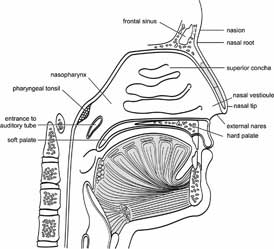What Is The Skin Between Your Nostrils Called
Anatomy of the Nose
The normal anatomy of the nose is shown in Figures i-3: the various terms used for nasal structures and dimensions (Fig. 1), the cartilaginous components of the olfactory organ and terms for regions (Fig. ii), and in Figure three the cross department is shown.
-

Effigy one
-

Figure two
-

Figure iii
Some anatomical landmarks deserve specific mention as these are not e'er used with standard significant.
- Nasal Root:
- The well-nigh depressed, superior role of the olfactory organ along the nasal ridge.
- Nasion:
- The midline bespeak but superior to the nasal root overlying the naso-frontal suture.
- Nasal Bridge:
- A saddle-shaped area that includes the nasal root and the lateral aspects of the nose. It lies between the glabella and the junior boundary of the nasal bone, and extends laterally to the inner canthi.
- Nasal Ridge:
- The midline prominence of the nose, extending from the nasal root to the tip (also called the dorsum of the nose).
- Nasal Base:
- An imaginary line betwixt the most lateral points of the external inferior attachments of the alae nasi to the confront.
- Nasal Tip:
- The junction of the junior margin of the nasal ridge and the columella. Ordinarily, information technology is the part of the nose furthest from the aeroplane of the face. In rare circumstances, such every bit markedly prominent and convex nasal profiles, other parts of the ridge may be further removed from the facial airplane.
- Ala:
- The tissue comprising the lateral boundary of the nose, inferiorly, surrounding the naris.
- Columella:
- The tissue that links the nasal tip to the nasal base, and separates the nares. It is the inferior margin of the nasal septum.
Measurements of the Olfactory organ
Measurements of the nose are possible using sliding calipers. The reliability of measurements using a tape measure is poor. Furthermore, the actual position of several of the landmarks may preclude accurate measurement. For instance, if the nasal tip overhangs the upper lip, the position of subnasale is difficult to ascertain [Hall et al., [2007]]. Nasal length and width are the most mutual measurements taken in practice. A short description of how to measure each dimension is provided as the various terms are defined.
Growth of the olfactory organ does not cease at puberty: the nose continues to increment in size with age. There are no normal standards for nasal size in adulthood.
The reader is referred to the Handbook of Normal Physical Measurements [Hall et al., [2007]] for detailed descriptions of measurement techniques, boosted nasal measurements not described here, and growth standards. Near are available for Caucasians of Northern European extraction only, and similar standards for other ethnicities are urgently needed.
Anatomical Variation
Anomalies of the nose may be classified into quantitative traits and qualitative features:
- Variations in length: long; short
- Variations in width: wide nose; narrow nose, wide nasal base; narrow nasal base; broad nasal tip; narrow nasal tip; wide nasal ridge; narrow nasal ridge; broad nasal bridge; narrow nasal bridge; broad columella.
- Variations in length and width: prominent nose; absent nasal cartilage; absent olfactory organ.
- Variations in shape or position: depressed nasal bridge; depressed nasal ridge; depressed nasal tip; bulbous nose; bifid nasal tip; bifid nose; overhanging nasal tip; deviated nasal tip; fullness of paranasal tissue; prominent nasal bridge; convex nasal ridge; concave nasal ridge; low insertion of the columella; low hanging columella; short columella; high insertion of the columella; thick ala nasi; underdeveloped ala nasi; fissure ala nasi; enlarged naris; narrow naris; unmarried naris; proboscis; supernumerary naris; anteverted nares.
Source: https://elementsofmorphology.nih.gov/anatomy-nose.shtml
Posted by: bethelhaecomming.blogspot.com


0 Response to "What Is The Skin Between Your Nostrils Called"
Post a Comment